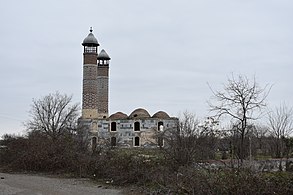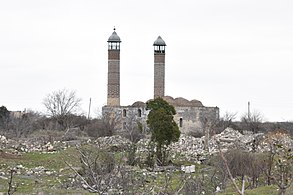Agdam Mosque
| Agdam Mosque | |
|---|---|
 The mosque in 2018 | |
| Religion | |
| Affiliation | Islam |
| Province | Agdam Rayon |
| Ecclesiastical or organizational status | Mosque |
| Location | |
| Location | Agdam, Azerbaijan |
| Architecture | |
| Architect(s) | Karbalayi Safikhan Karabakhi |
| Type | Mosque |
| Style | Islamic |
| Groundbreaking | 1868 |
| Completed | 1870 |
| Minaret(s) | 2 |
The Agdam Mosque (Template:Lang-az, also transliterated as Aghdam Mosque) is a mosque in the ghost town[1] of Agdam, de jure part of Azerbaijan, but de facto controlled by the Republic of Artsakh. It was one of the few buildings of the town that was not destroyed during the Nagorno-Karabakh War.[2]
History
The mosque was built by the architect Karbalayi Safikhan Karabakhi from 1868 to 1870. The mosque was built in the typical style for mosques in the Karabakh region, which included the division of stone columns on the two-story gallery and the use of domed ceilings. Other mosques in this style include Barda Mosque, the Yukhari Govhar Agha Mosque in Shusha, a mosque in Fizuli and one in the village of Goradiz.[3]
After Khojaly's invasion by Karabakh-Armenian forces on 29 February 1992, 200 bodies were first placed in this mosque.[4] However, according to mosque's director Seyid Sadiqov, the mosque had 477 corpses.[5]
Current state
Among the Aghdam's residential buildings, the mosque is one of the few still standing. According to Azerbaijani sources the roof and attic of the mosque have been pulled down, while windows, doors, interior finish, even the marble floor have been destroyed.[6]
In June 2010 Andrei Galafyev, a photographer who visited the mosque in 2007, reported that "The floor in the mosque is entirely dirtied with manure of cattle, which wanders on the ruins of Agdam in daytime.”[7] His photographs showed cattle within the mosque. This report generated criticism from Azerbaijani newspapers and a Turkish organization, who complained, claiming that the mosque is being used as a cowshed and pigpen.[7]
In November 2010 the government of Nagorno-Karabakh announced that the mosque and its surroundings had been cleaned.[8] They also announced that the mosque of Agdam, as well as the mosques of Shusha, have been refurbished.[2]
Gallery
-
the roof
-
the entrance
See also
References
- ^ Paul, Amanda (17 May 2011). "Agdam -- an Azerbaijani ghost town". Today's Zaman. Archived from the original on 2015-12-23. Retrieved 2015-10-13.
- ^ a b "Armenian Karabakh Official Says Mosques Being Repaired". Radio Free Europe/Radio Liberty. 18 November 2010.
- ^ ВЛИЯНИЕ ХРИСТИАНСТВА НА АРХИТЕКТУРУ АЗЕРБАЙДЖАНА (in Russian). Bakilililar.az. Retrieved 26 July 2010.
- ^ "Archived copy" ДОКЛАД ПРАВОЗАЩИТНОГО ЦЕНТРА «МЕМОРИАЛ» (in Russian). Memo.ru. Archived from the original on 31 July 2010. Retrieved 26 July 2010.
{{cite web}}: CS1 maint: archived copy as title (link) - ^ Goltz, Thomas. "Xocalı soyqırımı dünyanın gözü ilə". Xocalı Faciəsi (in Azerbaijani). Washington Post. Archived from the original on 2011-02-26. Retrieved 26 July 2010.
- ^ "Exposed: Armenians turned the mosque in Azerbaijani Agdam region into a." Today.az. Archived from the original on 26 July 2010. Retrieved 26 July 2010.
- ^ a b "Turks complain to Pope on vandalism in Karabakh church by Armenians". news.az. Archived from the original on 20 July 2010. Retrieved 26 July 2010.
- ^ "Works on preservation of Muslim cultural heritage in Nagorno-Karabakh underway". news.am. 17 November 2010.





